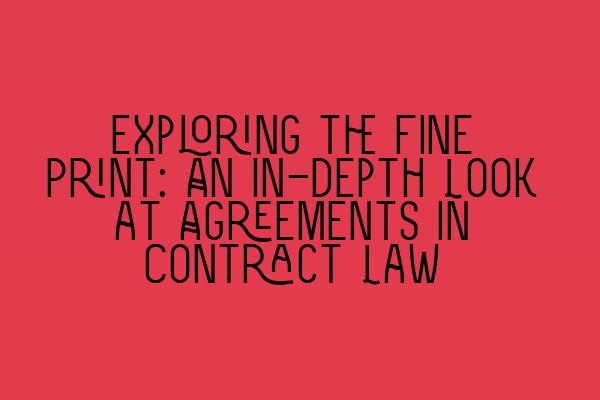Exploring the Fine Print: An In-depth Look at Agreements in Contract Law
Introduction
Contracts are an integral part of business transactions and legal relationships. They provide a framework for parties to define their rights, duties, and obligations. However, all too often, individuals and businesses enter into agreements without fully understanding the implications of the fine print. In this article, we will delve deep into the world of contract law, exploring the importance of understanding and analyzing agreements to protect your interests.
Understanding the Basics of Contracts
Before we delve into the fine print, let’s start with the basics. A contract is a legally binding agreement between two or more parties. For a contract to be valid, it must contain the following elements:
1. Offer: One party must make a clear and definite offer.
2. Acceptance: The other party must accept the offer unconditionally.
3. Consideration: There must be a mutual exchange of something of value between the parties.
4. Intent: The parties must intend to create legal relations.
5. Capacity: The parties must have the legal capacity to enter into the contract.
Exploring the Fine Print
Once the basic elements of a contract are established, it is essential to thoroughly examine and understand the fine print. The fine print, also known as the terms and conditions or the boilerplate clauses, often contains important details and conditions that can significantly impact the rights and obligations of the parties involved.
Let’s take a look at some key aspects of the fine print that must be carefully analyzed:
1. Definitions: Contracts may contain specific definitions for certain terms. It is crucial to review these definitions to ensure that both parties are interpreting the terms in the same manner throughout the contract.
2. Rights and Obligations: The fine print outlines the rights and obligations of each party. It is important to understand these provisions to ensure that your interests are protected. If necessary, seek legal advice to clarify any ambiguous terms or obligations.
3. Termination and Renewal: Contracts often have provisions regarding termination and renewal. Understanding the conditions and procedures for terminating or renewing a contract is essential to avoid potential legal disputes in the future.
4. Indemnification and Liability: Contracts may include provisions on indemnification and liability. Make sure you understand who is responsible for any damages or losses that may arise during the contractual relationship.
5. Dispute Resolution: The fine print may include a provision on how disputes between the parties will be resolved. This can include clauses for mediation, arbitration, or litigation. Understanding the chosen method for dispute resolution can help you navigate any potential conflicts effectively.
Protecting Your Interests
To protect your interests when entering into a contract, follow these essential steps:
1. Read and Understand: Take the time to thoroughly read and understand the entire contract, including the fine print. Seek clarification on any clauses or terms that are unclear to you.
2. Seek Legal Advice: If you are unsure about any aspects of the contract, consult with a solicitor who specializes in contract law. They can provide valuable insights and ensure that your interests are protected.
3. Negotiate and Modify: If you find any terms or conditions that are unfavorable to you, negotiate with the other party to modify the contract. Remember, contracts are negotiable, and both parties should work towards a mutually beneficial agreement.
4. Keep Records: Maintain detailed records of all communications, negotiations, and versions of the contract. These records can be valuable evidence in case of a dispute.
Conclusion
Understanding and analyzing the fine print is essential for anyone entering into a contract. Failing to do so can lead to unforeseen consequences and potential legal disputes. By taking the time to read and understand the agreement, seeking legal advice when necessary, and negotiating favorable terms, you can protect your interests and ensure a smooth contractual relationship.
Related Articles:
– SQE 1 Practice Exam Questions
– SQE 1 Practice Mocks FLK1 FLK2
– SQE 2 Preparation Courses
– SQE 1 Preparation Courses
– SRA SQE Exam Dates
By understanding the intricacies of contract law and paying close attention to the fine print, you can protect your rights and ensure a successful contractual relationship. Don’t let the details overwhelm you; instead, use them to your advantage.
